Canon B150 User Manual

FAX-B150
User's Guide
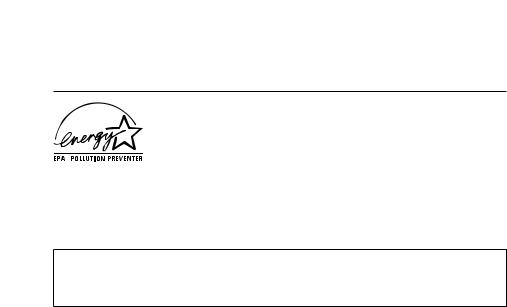
How to use this User's Guide
Before you use this user's guide, read this list of symbols, terms and abbreviations to become familiar with them. A complete glossary of terms is included at the end of this guide.
+Document
The original sheet(s) of paper you send, receive or copy with your fax.
+Menu
A list of options or features from which you select an item to set up or change.
+Numeric buttons
The round buttons on the operation panel with digits 0 through 9,  and # on them.
and # on them.
+Arrow buttons
The buttons  used to display choices and change settings. These buttons also change the volume setting of the speaker.
used to display choices and change settings. These buttons also change the volume setting of the speaker.
+STOP button
Press 

 to cancel any operation or to cancel the selection of a menu item.
to cancel any operation or to cancel the selection of a menu item.
+START/COPY button
Press  ) to start an operation or register a setting.
) to start an operation or register a setting.
+Transaction number
A number automatically assigned everytime you send or receive a fax. Transaction numbers are 4-digit numbers that can help you keep track of the documents you send and receive.
+TX/RX NO. XXXX
Represents the transaction number when displayed on the LCD, where XXXX is the 4-digit transaction number.
+TX
Stands for transmit or send.
+RX
Stands for receive.
important points and helpful hints, or how to avoid minor dif®culties.
ENERGY STAR Partner, Canon has determined that the FAX-B150
ENERGY STAR guidelines for energy ef®ciency.
Canon and BJ are registered trademarks, and Bubble Jet is a trademark of
Canon Inc.
Canon Inc. All rights reserved. No part of this publication may be reproduced, stored in a retrieval system, or translated into any language or computer
language in any form or by any means, electronic, mechanical, magnetic, optical, chemical, manual or otherwise, without the prior written permission of Canon Inc.
This CE Marking shows compliance of this equipment with Directive 73/23/EEC and Directive 89/336/EEC (as amended by Directive 92/31/EEC), both as amended by Directive 93/68/EEC.
Canon Inc./Canon Europa N.V.
ii
Welcome
Thank you for choosing the Canon FAX-B150 Bubble JetTM facsimile. The compact, upright design of the fax means it takes up less space in your work area. The bubble jet print mechanism uses cut-sheet plain paper, so you get crisp reproductions of your fax documents and copies.
The FAX has a number of features that make it ideal for small to medium-sized of®ces with a single telephone line.
Features
Plain paper
The fax accepts A4, letter, and legal size cut-sheet plain paper for crisp reproduction and faxes that are ¯at and easy to write on.
Automatic switching between fax and voice calls
The fax recognises incoming fax calls, and automatically switches to receive mode.
Automatic dialling
A variety of dialling methods allows you to register frequently used fax numbers and phone numbers and access them by pressing one or a few buttons.
Error Correction Mode (ECM) Tx / Rx
Automatically helps correct transmission errors due to system and telephone line noise.
Delayed transmission
Sends a fax automatically at a later time, for example, at night when telephone rates are lower.
360 dpi copy mode
Lets you make copies at 360 × 360 dpi.
iii

Notice for connection to telecommunication systems in the United Kingdom and the Republic of lreland
Approval Number 607721 (UK)
Your Canon FAX-B150 has been approved against the requirements of NTR3 for use in the UK and complies with the requirements of 91/263 EEC. The CE mark is applied in respect of the requirements of 72/23 EEC and 89/336 EEC. (UK)
It is intended for connection to analogue two wire public telecommunication networks.
Connect the supplied cable to this socket ®rst, then to the telephone line.
There are two auxiliary sockets to which equipment approved for direct connection to the network may be connected.
If required, a suitable adaptor, approved under Approval Number NS/G/23/L/100005 for direct and indirect connections between the fax machine and any piece of approved telecommunications apparatus, is available from your Canon supplier. (UK)
This socket is intended for connection of an answering machine or similar device.
This socket is intended for connection of a telephone.
Voltage and current available at these sockets is determined by the network to which the line cable is connected. They will not normally exceed the limits for TNV as described in EN60950.
Canon recommend that any additional equipment connected in the installation is connected to one of these sockets. Do not connect additional equipment through parallel sockets elsewhere on the telephone line.
This equipment is not intended or recommended for making calls to emergency services.
iv
For your safety (Australia only)
To ensure safe operation the three-pin plug supplied must be inserted only into a standard three-pin power point which is effectively earthed through the normal household wiring.
Extension cords used with the equipment must be three-core and be correctly wired to provide connection to earth.
Wrongly wired extension cords are a major cause of fatalities. The power point shall be located near the equipment and shall be easily accessible.
The fact that the equipment operates satisfactorily does not imply that the power point is earthed and the installation is completely safe. For your safety, if in any doubt about the effective earthing of the power point, consult a quali®ed electrician.
Caution (New Zealand only)
1.This equipment may not necessarily provide for the effective hand-over of a call to or from a telephone connected to the same line.
2.The Operation of this equipment on the same line as telephone or other equipment with audible warning devices or automatic ring detectors will give rise to bell rinkle or noise and may cause false tripping of the ring detector. Should such problems occur, the user is not to contact telecom faults service.
3.Should this equipment become physically damaged, disconnect immediately from the Telecom connection and power source and contact your nearest service agent.
4.To relocate this equipment please.
1)Disconnect the equipment from the Telecom connection.
2)Disconnect the equipment from the power source.
3)Reconnect the equipment to the power source.
4)Reconnect the equipment to the Telecom connection.
5.If the supply cord of this equipment is damaged, it must be replaced by the special cord (Parts No.:HH2-1910).
6.Not all standard telephones will respond to incoming ringing when connected to the extension socket.
v
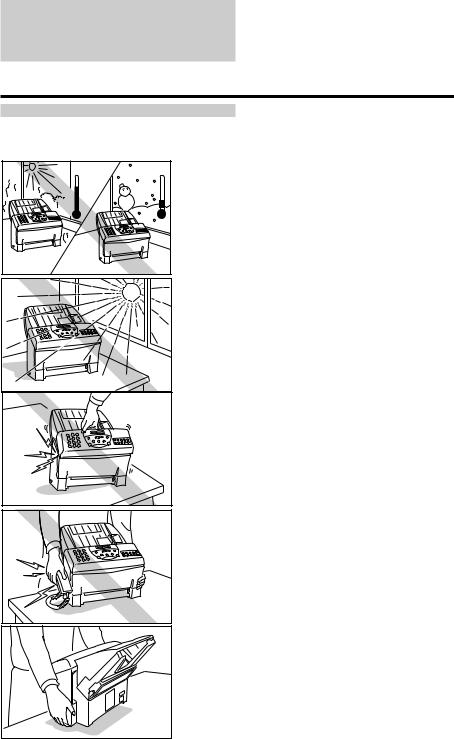
Precautions
General
Make sure the place where you set up the fax satis®es the following conditions:
Over 32.5°C |
Under 10°C |
∙Use the fax only within the following range of temperature and humidity ranges.
Ambient temperature: 10ë to 32.5 Cë Ambient humidity:
10% to 80% RH (no condensation)
∙Keep your fax out of direct sunlight, as this can damage the unit.
∙ Do not lift the fax by the operation panel.
∙If you have installed the optional handset, do not lift the fax by the handset cradle.
∙ Hold the fax as shown when transporting it.
vi
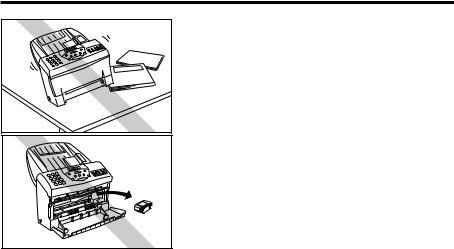
PRECAUTIONS
∙ Place the fax on a level surface.
∙Do not remove the BJ cartridge from the unit unless it needs to be replaced, or when transporting the fax. Removing the
cartridge and leaving the print head unprotected will cause it to dry out and become unusable.
∙Do not place the fax on the edge of a desk so as to prevent received documents falling onto the ¯oor.
∙Certain table surfaces may prevent received documents from sliding out smoothly, resulting in paper jams. Do not place the fax on these types of tables.
∙Do not install the fax near devices which contain magnets or generate magnetic ®elds.
∙Do not subject the fax to strong physical shock or vibration.
∙Keep the fax clean. Dust accumulation can prevent the fax from operating properly.
∙Before you transport your fax, make sure to remove the BJ cartridge and recover the print head with the orange tape. After moving the fax, remove the orange tape and reload the BJ cartridge.
Others
Here are some other general precautions when you are using or working around it.
CAUTION
∙Avoid installing your fax in places exposed to direct sunlight, dust, vibration, high temperature or humidity, or on unstable surfaces.
∙To assure proper electrical contact, make sure the fax is ®rmly plugged in.
∙Never pull on the cord to unplug the fax. Pull on the plug itself.
WARNING
∙Do not overload the electrical outlet where the fax is plugged in.
∙Never plug or unplug the fax when your hands are wet.
∙For your safety, unplug the fax during electrical storms.
∙If you have problems with the fax (smoke, odd smells or noises), immediately unplug the fax from the outlet. Keep the area around the outlet free from clutter so you can unplug the fax quickly in case of an emergency.
∙Never use liquids or drink beverages around the fax. Liquids spilled on the fax can cause a ®re or electrical shock. If you accidentally spill a liquid on the fax, unplug it immediately and call your Canon service representative.
∙To avoid electrical shock from exposed power points, never disassemble the fax. There are no parts or switches in the fax that require adjustment.
vii

Table of Contents
INTRODUCTION
1. SETTING UP
How to use this User's Guide ................................ |
ii |
Welcome ................................................................... |
iii |
Features .................................................................... |
iii |
Notice for connection to telecommunication |
|
systems in the United Kingdom and Republic |
|
of lreland .............................................................. |
iv |
For your safety (Australia only) .............................. |
v |
Caution (New Zealand only) ................................... |
v |
Precautions .............................................................. |
vi |
General ............................................................................. |
vi |
Others ............................................................................... |
vii |
Unpacking ................................................................ |
2 |
Removing the shipping materials .................................... |
4 |
Assembling the fax .................................................. |
5 |
Attaching components .................................................... |
5 |
Attaching the handset ..................................................... |
6 |
Connecting the AC power cord ....................................... |
6 |
Loading the paper ................................................... |
7 |
Selecting the right kind of paper ..................................... |
7 |
Loading the paper ........................................................... |
7 |
Installing the BJ cartridge ...................................... |
9 |
BJ cartridge guidelines .................................................... |
9 |
Handling the BJ cartridge ................................................ |
10 |
Installing the BJ cartridge ................................................ |
11 |
Connecting the phone line ..................................... |
14 |
Connecting to the wall jack ............................................. |
14 |
Connecting the telephone ............................................... |
14 |
Connecting the optional handset .................................... |
15 |
Connecting an extension phone or answering machine |
|
(optional) ..................................................................... |
15 |
Setting the TEL LINE TYPE ............................................. |
16 |
Setting up to receive faxes .................................... |
17 |
Selecting the receiving mode .......................................... |
17 |
Fax Only Mode ................................................................. |
18 |
Fax/Tel Mode ................................................................... |
19 |
Manual Mode ................................................................... |
20 |
Ans. Machine Mode ......................................................... |
21 |
2.PREPARING TO USE YOUR FAX
Main components of the fax .................................. |
24 |
Front view ......................................................................... |
24 |
Rear view ......................................................................... |
25 |
Fax controls ± the Operation Panel ....................... |
26 |
Registering your name and number ..................... |
28 |
Moving through the main menus .................................... |
28 |
Entering a number ........................................................... |
30 |
Entering a name ............................................................... |
30 |
Personalising your fax ..................................................... |
32 |
Registering the date and time ......................................... |
33 |
Registering your telephone/fax number and name ........ |
34 |
viii

Table of Contents
3.HANDLING DOCUMENTS
4.MAKING COPIES
5.SENDING FAXES
6.RECEIVING FAXES
Registering One-touch Speed Dialling numbers |
|
and names ........................................................... |
36 |
Registering Coded Speed Dialling numbers and |
|
names .................................................................. |
38 |
Special dialling ......................................................... |
39 |
Registering the access type and the outside line |
|
number ....................................................................... |
40 |
Using alternative telephone networks (UK only) . 42 |
|
Attaching the M label ....................................................... |
42 |
Registering an alternative telephone network ................ |
42 |
Sending with a registered long-distance service ........... |
44 |
Registering speed dialling with the M button ................. |
45 |
Preparing documents ............................................. |
48 |
Types of documents you can scan ................................. |
48 |
Loading the document .................................................... |
49 |
Setting the resolution and density .................................. |
51 |
Copying documents ................................................ |
54 |
Preparing to send a document .............................. |
56 |
Sending methods ............................................................. |
56 |
Dialling methods .............................................................. |
56 |
Sending documents ................................................ |
57 |
Direct Sending ................................................................. |
57 |
Manual Sending ............................................................... |
57 |
Automatic Dialling ............................................................ |
58 |
Memory Sending ............................................................. |
59 |
Cancelling Sending .......................................................... |
60 |
Redialling .......................................................................... |
60 |
Messages displayed during sending .............................. |
61 |
Clearing document jams (ejecting a document from the |
|
ADF) ............................................................................ |
62 |
Delayed Sending ...................................................... |
63 |
Sending other documents while the fax is set for |
|
Delayed Sending ........................................................ |
64 |
Cancelling Delayed Sending ........................................... |
65 |
Sequential broadcasting ........................................ |
66 |
Sending a document to more than one location ............ |
66 |
Receiving documents ............................................. |
68 |
Receiving documents in Manual Mode .......................... |
68 |
Receiving documents in Fax Only Mode ........................ |
69 |
Receiving documents in Fax/Tel Mode ........................... |
69 |
Receiving documents in Ans. Machine Mode ................ |
70 |
Receiving documents in memory .................................... |
71 |
Printing documents in memory ....................................... |
72 |
Receiving while registering, copying or printing ............. |
72 |
ix

Table of Contents
7.SETTINGS AND ACTIVITY REPORTS
Network FAX/TEL Switching (Australia only) ...... |
73 |
Setting the fax for Network Switch ................................. |
73 |
Operation for Network Switch System ........................... |
74 |
Network FAX/TEL Switching (New Zealand |
|
only) ...................................................................... |
75 |
Setting the fax Network ................................................... |
75 |
Operation for Network Switch System ........................... |
76 |
User menu settings ................................................. |
78 |
Settings ..................................................................... |
81 |
How to change a setting ................................................. |
81 |
Activity reports ........................................................ |
87 |
How to print a report ....................................................... |
87 |
Activity management report ............................................ |
88 |
One-touch Speed Dialling list .......................................... |
88 |
Coded Speed Dialling list ................................................ |
89 |
User's data list ................................................................. |
90 |
Activity report (Sending) .................................................. |
90 |
Activity report (Receiving) ................................................ |
91 |
Multi-activity report .......................................................... |
91 |
Memory clear list ............................................................. |
92 |
Restricting use of the fax ....................................... |
93 |
Locking the fax ................................................................ |
93 |
Changing the access password ...................................... |
94 |
Cancelling the restriction setting ..................................... |
95 |
8.SOLUTIONS TO COMMON PROBLEMS
Paper jams ............................................................... |
98 |
Automatic Document Feeder (ADF) jams ....................... |
98 |
Recording paper jams ..................................................... |
99 |
Periodic care ............................................................ |
100 |
Cleaning the fax exterior ................................................. |
100 |
Cleaning the glass scanning window .............................. |
100 |
Cleaning the printer area ................................................. |
101 |
Cleaning the BJ cartridge print head .............................. |
102 |
Replacing the BJ cartridge .............................................. |
103 |
Frequently Asked Questions .................................. |
104 |
TRANSMITTING ............................................................... |
104 |
RECEIVING ...................................................................... |
105 |
TELEPHONE .................................................................... |
106 |
COPYING ......................................................................... |
107 |
PAPER LOADING PROBLEMS ....................................... |
107 |
GENERAL ......................................................................... |
107 |
Print quality problems ............................................. |
109 |
Error codes, messages and solutions .................. |
110 |
In case of a power failure ....................................... |
113 |
During a power failure ..................................................... |
113 |
x

Table of Contents |
|
Speci®cations ................................................................................................................... |
115 |
Appendix ........................................................................................................................... |
117 |
Document sizes ................................................................................................................................ |
117 |
What happens when Fax/Tel Mode is selected .............................................................................. |
118 |
Glossary ............................................................................................................................ |
119 |
Index .................................................................................................................................. |
123 |
xi
This page is intentionally blank.

1 SETTING UP |
|
Unpacking ................................................................ |
2 |
Removing the shipping materials .................................... |
4 |
Assembling the fax .................................................. |
5 |
Attaching components .................................................... |
5 |
Attaching the handset ..................................................... |
6 |
Connecting the AC power cord ....................................... |
6 |
Loading the paper ................................................... |
7 |
Selecting the right kind of paper ..................................... |
7 |
Loading the paper ........................................................... |
7 |
Installing the BJ cartridge ...................................... |
9 |
BJ cartridge guidelines .................................................... |
9 |
Handling the BJ cartridge ................................................ |
10 |
Installing the BJ cartridge ................................................ |
11 |
Connecting the phone line ..................................... |
14 |
Connecting to the wall jack ............................................. |
14 |
Connecting a telephone .................................................. |
14 |
Connecting the optional handset .................................... |
15 |
Connecting an extension phone or answering machine |
|
(optional) ..................................................................... |
15 |
Setting the TEL LINE TYPE ............................................. |
16 |
Setting up to receive faxes .................................... |
17 |
Selecting the receiving mode .......................................... |
17 |
Fax Only Mode ................................................................. |
18 |
Fax/Tel Mode ................................................................... |
19 |
Manual Mode ................................................................... |
20 |
Ans. Machine Mode ......................................................... |
21 |
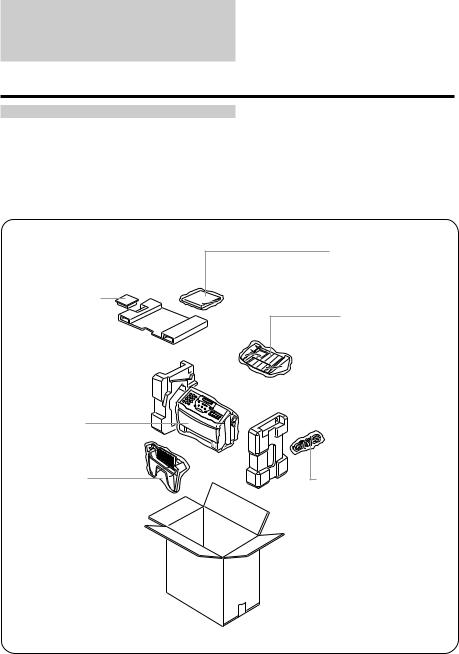
Unpacking
As you unpack the fax, save the carton and packing material in case you want to move or ship the unit in the future.
Carefully remove all items from the box.
¦It is best to have someone hold the box while you lift the fax and its protective packaging out of the carton.
User's guide
BX-3 BJ FAX
cartridge
Paper tray cover
Main unit |
|
Paper tray |
Power cord and Telephone |
|
line |
2
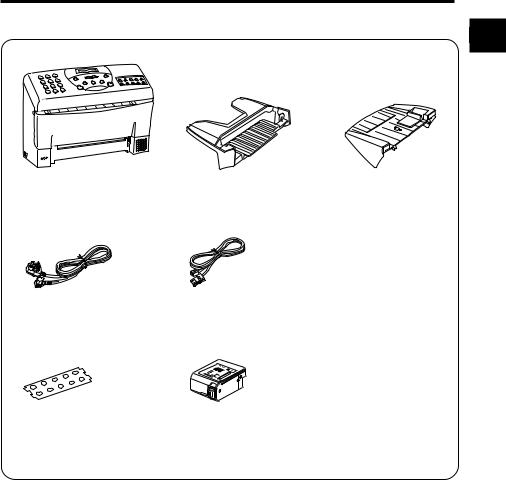
UNPACKING
If any of these items are damaged or missing, notify your Canon dealer immediately.
1
Main unit |
Paper tray |
Paper tray cover |
Power cord* |
Telephone line** |
Miscellaneous
¦ User's Guide (This manual)
¦ M Label (UK only)
Overlay |
BX-3 BJ FAX cartridge |
*The shape of the power cord varies depending on the country of purchase.
**The shape of the telephone line varies depending on the country of purchase.
3
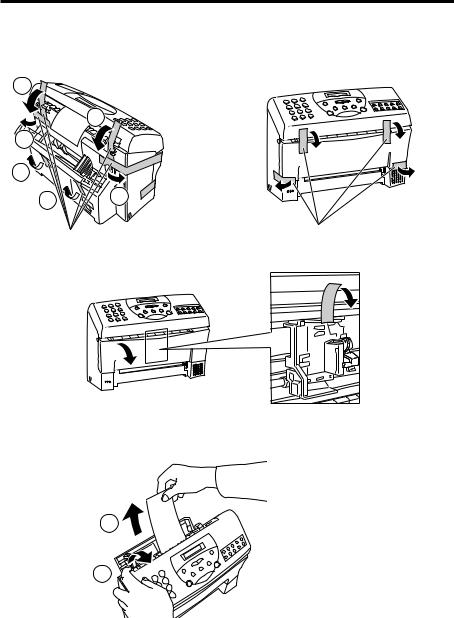
SETTING UP
Removing the shipping materials
Remove the shipping materials as shown below.
2 |
|
2 |
|
1 |
|
3 |
|
3 |
1 |
Remove these tapes |
Remove these tapes |
|
Open the front cover
Remove this tape
Pull 2
Open 1
Be sure to also remove any shipping materials from the paper tray cover and the paper tray.
4
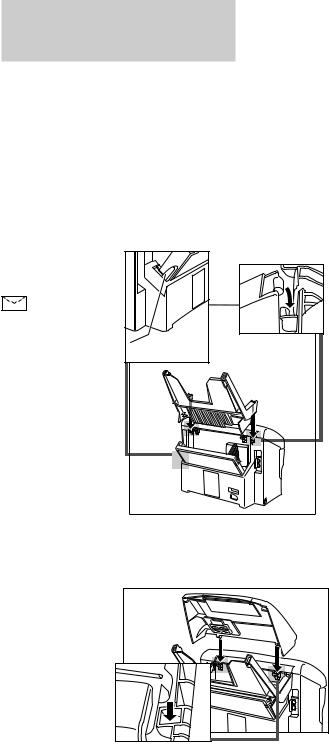
Assembling the fax |
1 |
||
|
|
|
|
|
|
|
|
|
|
|
|
To see how the fax looks fully assembled, see Main components of the fax, p. 24.
Attaching components
j Paper Tray
Make sure the paper lever is in the position  . Then place the paper tray into the fax, making sure the two knobs ®t in the appropriate slots on the fax.
. Then place the paper tray into the fax, making sure the two knobs ®t in the appropriate slots on the fax.
This symbol indicates the use of a function (envelope printing) not available with this model.
Paper lever |
j Paper Tray Cover
Place the paper tray cover over the paper tray, making sure the two tabs ®t in the appropriate slots on the fax.
5
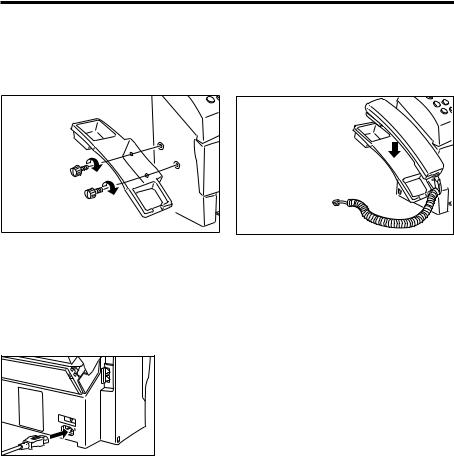
SETTING UP
Attaching the optional handset*
* The handset is available as an optional in some countries.
1 Attach the handset cradle. |
2 Place the handset on its cradle. |
Please release the screw.
Connecting the AC power cord
Plug the fax into a 200 240 volt AC 50/60 Hz outlet.
1 |
Plug the power cord connector into the |
rear of the unit. |
2 |
Plug the other end of the power cord |
into a properly grounded AC outlet. |
There is no power switch on the fax. The power is on as long as the fax is plugged in.
6

Loading the paper |
1 |
||
|
|
|
|
|
|
|
|
|
|
|
|
Selecting the right kind of paper
The quality of the paper you use affects the print quality of the fax. Using paper that meets the following speci®cations will ensure the best possible printing results.
Quality |
Use plain bond, typewriter quality without curls, folds, or rough edges. |
|
|
Weight |
64-90 g/m2 |
Thickness |
0.08 mm-0.12 mm |
|
|
Storage |
18° to 24° C, 40% to 60% relative humidity. |
|
|
Size |
A4, Letter, Legal |
|
|
Note
¦Test the plain bond paper you intend to use ®rst to make sure printing results are satisfactory.
¦Do not use punched or coloured paper.
¦Do not use glossy paper.
¦Ink drying time will vary depending on the type of paper.
¦Using paper other than the above may cause jamming and/or blurred printing.
j Setting the paper size
The paper size setting determines the size of the recording paper in the paper tray.
The factory setting is A4 size. If you want to use a paper size other than A4, you must change the PAPER SIZE setting. See FAX PRINTER, p. 86.
Loading the paper
1 |
Remove the paper tray cover. |
2 |
Fan a small stack of up to 100 sheets (up |
|
to 10 mm thick). Tap the edge of the |
stack on a ¯at surface to even the stack.
7 |

SETTING UP
3 |
Align the right edge of the paper stack |
with the right edge of the paper tray and |
insert halfway into the paper tray.
4 |
Holding the paper of stack, squeeze and |
slide the paper guide until it touches the |
left edge of the stack of paper.
Make sure the stack of paper does not exceed the paper limit mark on the right side of the paper tray.
5 |
Insert the paper stack into the paper tray |
6 |
Replace the paper tray cover. |
until it stops. |
|
A4 |
LTR |
A4 |
LTR |
Do not force the paper down into the fax.
Note
¦Make sure the stack of the paper is ¯at, held upright and aligned with the left paper guide.
¦The top edge of the stack does not need to be even.
8
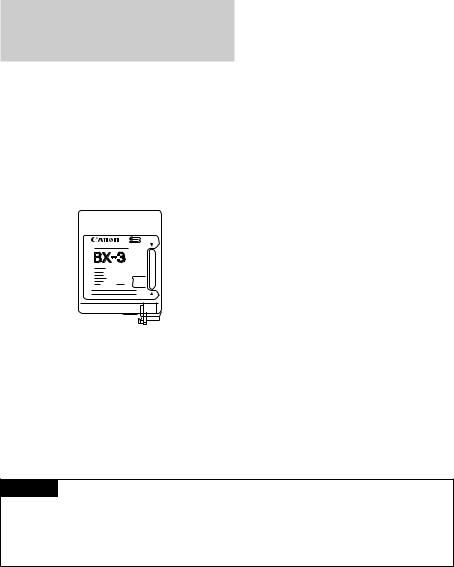
Installing the BJ cartridge |
1 |
||
|
|
|
|
|
|
|
|
|
|
|
|
The ®rst time you set up your fax, you have to install the BX-3 BJ FAX cartridge before you can begin receiving and copying documents.
BJ cartridge guidelines
Use only the Canon BX-3 BJ FAX cartridge with the FAX-B150.
The actual amount of ink that you use will vary depending on the print density of a page. If the majority of your printed output is graphics, you may need to change the ink cartridge more often than when you are receiving or copying text only.
You may need to replace the BJ cartridge when either of the following conditions exist:
¦Your printed output is not crisp and clear, and there are gaps in the characters (missing dots) even after you have cleaned the print head once or twice and you have removed and reinstalled the BJ cartridge.
¦You have been using the BJ cartridge for over one year.
Note
¦To ensure optimum print quality, Canon recommends the use of the cartridges designated by Canon. Canon accepts no liability or responsibility for damages caused by the use of any cartridge other than those designated by Canon.
¦Canon makes numerous ink cartridges; the BX-3 BJ FAX cartridge is the only one designed to be used with the FAX-B150.
9
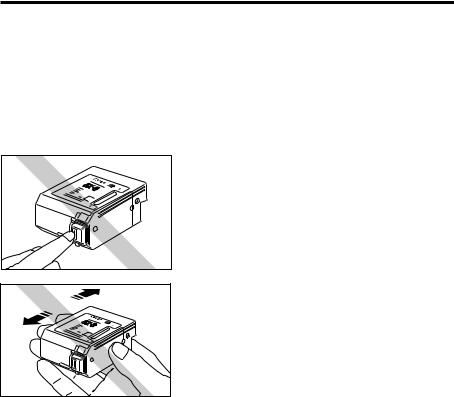
SETTING UP
Handling the BJ cartridge
¦Leave the BJ cartridge in its packaging until you are ready to use it to prevent it from drying out.
¦Store BJ cartridges out of the reach of children. The ink contains isopropyl alcohol 67-63-0.
¦Replace the BJ cartridge after one year of use or if the print is not clear or is missing, even after trying ®ve successive head cleanings.
¦Never remove the BJ cartridge unless you are going to replace it. When left exposed, the cartridge print head dries out, making it unusable.
¦Do not touch the print head area on the BJ cartridge. Ink may leak out and cause stains.
¦ Never shake the BJ cartridge, especially after removing the protective tape from the print head.
If spilled, the ink is very dif®cult to clean. Therefore, always follow the above precautions and carefully handle the BJ cartridge.
10
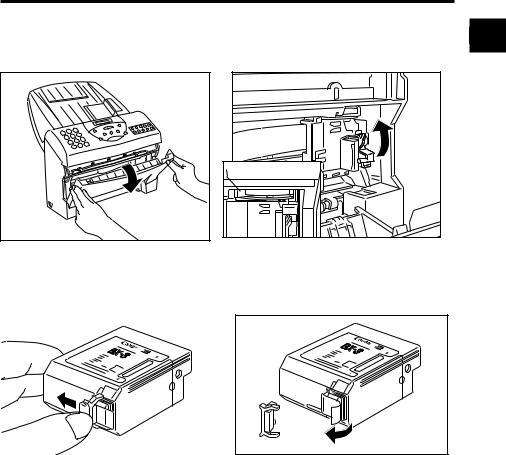
INSTALLING THE BJ CARTRIDGE
Installing the BJ cartridge
1 Open the front cover of the fax.
1
2 Raise the green cartridge release lever. |
Thickness lever |
Make sure the paper thickness lever is set to the paper position (left position).
3 |
Remove the print head cap from the BJ |
cartridge. |
|
|
|
4 Pull off the protective orange tape. |
11
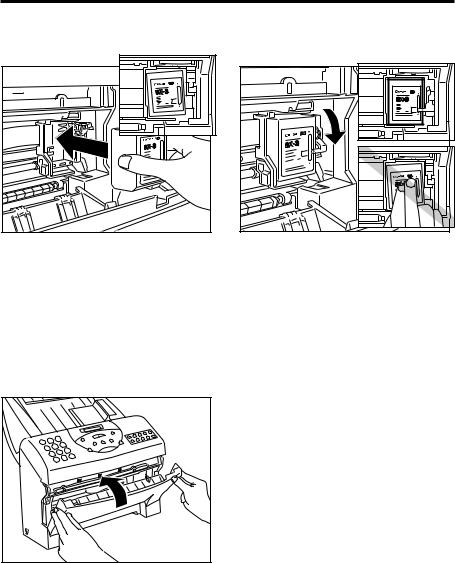
SETTING UP
5 |
Insert the BJ cartridge. Align the slot in |
the cartridge with the yellow post in the |
fax.
6 |
Lower the cartridge release lever down |
until you hear a click to lock the |
cartridge in place.
The yellow post (BJ cartridge guide) should be visible through the slot. The BJ cartridge tilts slightly to the left in the loaded position.
7 Close the front cover of the fax. |
¦Make sure the arm on the cartridge release lever aligns with the marking on the BJ cartridge.
¦If the lever movement is not smooth, release the lever and reload it.
¦To avoid cartridge misalignment and an error message appearing, do not press down on the cartridge or try to align it manually while raising and lowering the green lever.
12
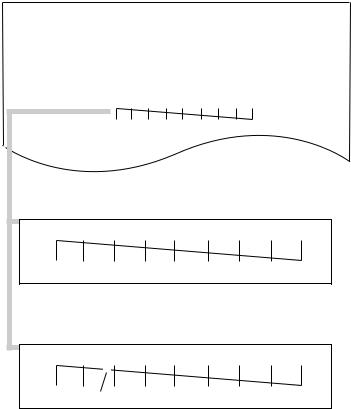
|
INSTALLING THE BJ CARTRIDGE |
|
|
|
8 |
The fax automatically prints a test page. |
|
|
|
1 |
|
|||
The fax prints a test page every time you insert a BJ cartridge. |
|
|||
|
|
|||
|
|
|
|
|
TEST PRINT
This is a test sheet designed to test the print quality of this unit. Please refer to the test patterns below. If they are not printed clearly, you may want to clean the print head of the ink cartridge. To clean the ink cartridge, please press [FUNCTION] then [CLEANING] button.
When the BJ cartridge is properly installed, the test printout should look as shown above.
White streak |
If the printout has white streaks as shown above, try cleaning the print head. See Cleaning the BJ cartridge print head, p. 100. If the problem persists after cleaning, try reinstalling the BJ cartridge.
¦You can turn off automatic test printing by changing the AUTO TEST PRINT setting. See SYSTEM SETTINGS, p. 86.
13

Connecting the phone line
Connecting to the wall jack
1 fax.Connect one end of the supplied telephone line to the jack marked  on the rear of the
on the rear of the
2 Connect the other end of the line to your wall telephone jack.
Note
¦To avoid electrical shock, connect the telephone line to the fax ®rst. Then connect the line to the wall telephone jack.
Connecting the telephone
1 Connect the end of the telephone cord to the jack.
B.T. adaptor |
UK only
¦Users in the UK only:
When you connect a telephone, be sure to connect the B.T. adaptor. Contact your Canon supplier for more information.
14
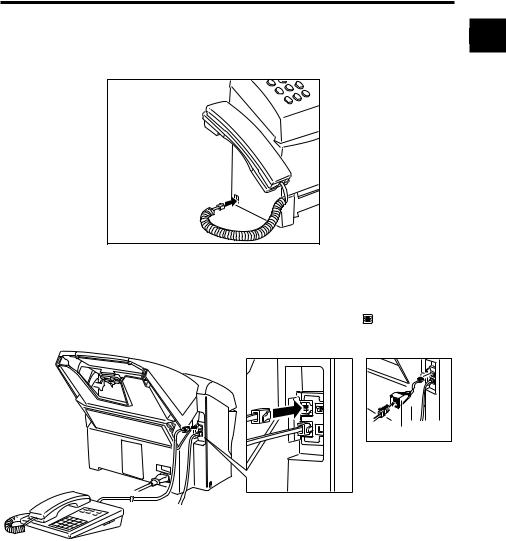
CONNECTING THE PHONE LINE
Connecting the optional handset
1
1 Connect the handset's modular jack to the handset jack on the fax.
Connecting an extension phone or answering machine (optional)
1 |
Connect an extension phone or answering machine to the jack marked |
on the rear of |
the fax. |
|
B.T. adaptor |
UK only
¦Be sure to connect an extension phone if you want to use the INCOMING RING feature and you want it to ring when the fax receives a call, See pp. 69, 85.
¦If you connect an answering machine, refer to Ans. Machine Mode, p. 21.
¦Users in the UK only:
When you connect an extension phone or answering machine, be sure to connect the B.T. adaptor. Contact your Canon supplier for more information.
15
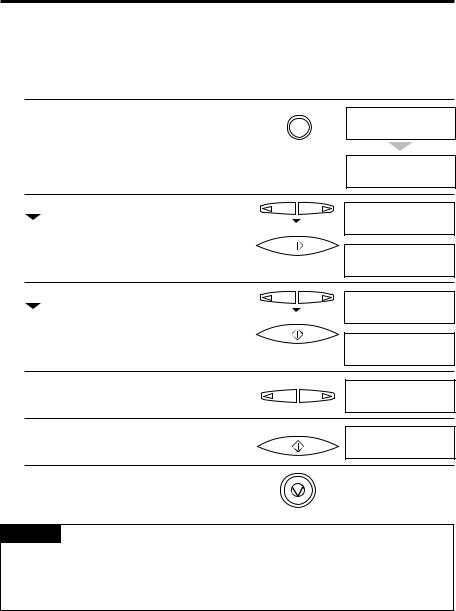
SETTING UP
Setting the TEL LINE TYPE*
Your fax is factory set to work with rotary pulse telephone lines**. If you have a tone line, you will need to change the telephone line setting as follows.
*TEL LINE TYPE cannot be set in Hong Kong, Norway and Denmark.
**The factory default setting for the UK and Singapore is touch tone.
1 Press [FUNCTION].
Wait a second for TEL REGISTRATION to appear.
FUNCTION
SELECT MENU
1 sec.
TEL REGISTRATION
2
3
4
5
6
Use [ ] or [
] or [ ] to select USER SETTINGS.
] to select USER SETTINGS.
USER SETTINGS
Press [START/COPY]. |
START/COPY |
SET DATE
Use [ ] or [
] or [ ] to select TEL LINE TYPE.
] to select TEL LINE TYPE.
TEL LINE TYPE
Press [START/COPY]. |
START/COPY |
ROTARY PULSE
Use [ ] or [
] or [ ] to select TOUCH TONE.
] to select TOUCH TONE.
TOUCH TONE
Press [START/COPY]. |
START/COPY |
DATA ENTRY OK
Press [STOP] to ®nish.
STOP
Note:
Users in the UK only:
Although this equipment can use either rotary pulse or touch tone, only the performance of the touch tone is subject to regulatory requirements for correct operation. It is therefore strongly recommended that the equipment is set to use touch tone for access to public or private emergency services. Touch tone also provides faster call set up.
16

Setting up to receive faxes |
1 |
||
|
|
|
|
|
|
|
|
|
|
|
|
Selecting the receiving mode
Before you set up the receiving mode on your fax, you should determine how you plan to use your fax:
¦Are you able to dedicate the use of one telephone line to the fax only to receive document transmissions from other fax machines? If yes, choose Fax Only Mode (see below).
¦Do you want to use your fax as both a telephone and fax, receiving documents automatically and ringing only for telephone calls? If yes, choose Fax/Tel Mode (see below).
¦Do you want to use your fax mainly as a telephone, and answer every call yourself, whether from a person or a fax unit? If yes, choose Manual Mode (see below).
¦Do you want to connect an answering machine to your fax and receive the other party's document and also record the other party's message? If yes, choose Ans. Machine mode (see below).
How you answer these questions will determine which receiving method you choose. If you are not satis®ed with the mode you select, you can always change it at any time.
j Fax Only Mode (See p. 18)
You may want to use this mode if you have two phone lines in your of®ce, and plan to use one line for the fax and the other line for your telephone.
Set Fax Only Mode if you want to use your fax only to receive faxes automatically and do not intend to use it as a telephone.
j Fax/Tel Mode (See p. 19)
If you only have one phone line in your of®ce, you may be planning to use it for both fax and telephone communication. By setting this mode, you will be able to use your fax for both fax and telephone communication using only one phone line. You will need to have the optional handset or an extension phone connected to the fax so that when it rings to alert you of a call, you can answer the call. The fax will automatically receive faxes without ringing.
j Manual Mode (See p. 20)
Use Manual Mode if you receive more telephone calls than faxes. By having a telephone or the optional handset connected to your fax, you can answer every call, whether from a person or from another fax unit. If you hear a slow beep, simply press [START/COPY] on your fax and hang up the handset to receive the fax.
j Ans. Machine Mode (See p. 21)
Use Ans. Machine Mode if you have an answering machine connected to the fax. This mode allows you to receive not only documents sent from other fax machines, but also messages from people calling when you are out.
17
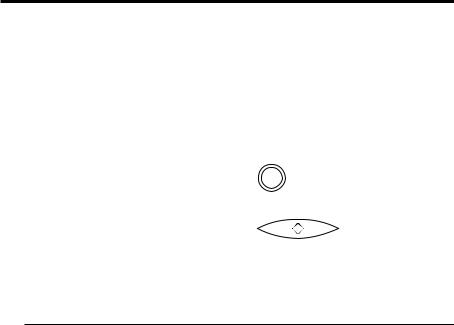
SETTING UP
Fax Only Mode
The fax is set up at the factory to Fax/Tel Mode. If you have a dedicated fax line, you need to set the mode to Fax Only.
j Setting Fax Only Mode
When you set the fax to Fax Only Mode, the unit picks up every call and automatically treats it as a fax transmission.
The fax cannot receive automatically if you are making copies, printing reports, or registering information. See p. 72.
1 |
|
Press [RECEIVE MODE] until ²Fax Only Mode² |
|
|
|
|
|
|
|
|
|
||
|
appears on the LCD. |
RECEIVE MODE |
Fax Only Mode |
|||
2 |
|
|
|
|
|
|
|
|
|
|
|
|
|
|
Press [START/COPY]. |
START/COPY |
|
|
||
|
When this mode is set, the LCD will display the |
|
|
12:00 |
FaxOnly |
|
|
time and ²FaxOnly². |
|
|
|
|
|
|
|
|
|
|
||
j Receiving documents in Fax Only Mode
When the fax is set to Fax Only Mode, it automatically receives documents whenever a call comes over the fax line.
1 Make sure the fax is set to ²Fax Only Mode²
(see above).
The fax assumes all incoming calls are from another fax machine sending a document. It receives the documents automatically.
18
